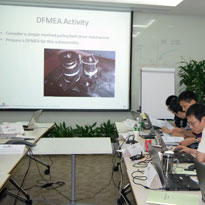Fault Tree Analysis
- Course:Fault Tree Analysis
- Course ID:FTREE1 Duration:2 days Where: Your Office (7+ Persons)
- Download Course Description (PDF)
Available as a private, customized course for your group at your offices or ours and in some cases as a WebLive(TM) class.
Course Outline
Fault Tree Analysis: Introductory Concepts.
- Fault tree analysis history, applications, purposes, and capabilities.
- Definitions.
- Fault tree analysis as a predictive tool.
- How fault tree analysis can predict the probability of an undesired
condition. - Fault tree analysis applied to complex system failures.
- Fault tree analysis, Ishikawa diagram, and FMEA comparisons.
- Related military and commercial standards.
- Case study. Group activity.
Fault Tree Analysis: Fault Tree Analysis Approach.
- Defining the undesired system condition or failure condition.
- The concept of a top undesired event.
- Inductive versus deductive logic.
- Fault tree analysis symbology.
- Defining the fault tree analysis top tier.
- The concept of gates and events.
- F-16 Air Combat Fighter case study.
- Group activity.
Fault Tree Analysis: Fault Tree Analysis Events.
- Command events.
- The top undesiredevent.
- Basic failure events.
- Normal events.
- Human error events.
- Undeveloped events.
- Criteria for assigning undeveloped events.
- Group activity.
Fault Tree Analysis: Fault Tree Analysis Gates.
- OR gates.
- AND gates.
- INHIBIT gates.
- Exclusive OR gates.
- Sequential AND gates.
- INHIBIT conditions.
- Case study.
- Group activity.
Fault Tree Analysis: Fault Tree Analysis Construction.
- Relationships between logic operators and events.
- Top undesired events.
- The top tier. Developing fault tree logic.
- Fault tree tiers.
- Fault tree construction.
- Navigating through the system.
- The advantages of navigation-based fault tree construction versus listing all events on a single tier.
- Case study.
- Group activity.
Fault Tree Analysis: Advanced Fault Tree Analysis Construction.
- State of the part and state of the system considerations.
- Using state of the part considerations to identify additional events based on environmental, command, and component failure mechanisms.
- Case study.
- Group activity.
Fault Tree Analysis: Fault Tree Analysis Quantification.
- Probability and statistics applied to fault tree analysis.
- Failure rate and probability considerations for basic failures, normal events, human errors, undeveloped events, and inhibit conditions.
- Mean Time Between Failures, failure rates, and probability relationships.
- Operating/mission time considerations.
- Dormant versus active failure rate considerations.
- Failure rate sources.
- Environmental effects on failure rates.
- Determining event, branch, and top undesired event probability of occurrence.
- Case study.
- Group activity.
Fault Tree Analysis: Root Cause Failure Analysis.
- Fault tree applications to the root cause failure analysis process.
- Component versus system failures.
- Defining the failure.
- The root cause failure analysis approach.
- Fault tree analysis, failure mode assessment and assignment matrices, supporting analysis, and managing the failure analysis.
- Case study.
- Group activity.
Fault Tree Analysis: Redundancy Considerations.
- Using fault tree analysis to identify single point failures or other conditions that can defeat redundant circuitry and other fail-safe design approaches.
- Case study.
- Group activity.
Fault Tree Analysis: Fault Tree Cut Sets.
- Cut set and minimal cut set definitions.
- Identifying fault tree analysis cutsets.
- Cut set order.
- Cut set and reliability block diagram comparisons.
- Using cut sets to identify single failure points.
- Case study.
- Group activity.
Fault Tree Analysis: Fault Tree Analysis Software.
- Manually generated versus computer generated fault tree analysis.
- Computer aided fault tree analysis (CAFTA).
- Web-based software.
- Using Visio for fault tree analysis. Using Excel for quantifying fault tree analysis.
- Other available fault tree analysis software.
- Case study.
Fault Tree Analysis: Post-Fault-Tree Activities and Course Wrap-Up.
- Managing fault tree findings.
- Fault tree analysis as an engineering development risk mitigation tool.
- Course wrap up and critique.
Course in a Nutshell
Complex products and processes include the potential for systems failures induced as result of human error, manufacturing error, environmental conditions, component failures, and combinations of these conditions. Fault tree analysis is a powerful tool designed to identify potential causes of specific undesired system conditions.
Initially developed specifically to identify and prevent events and combinations of events that could induce an inadvertent nuclear weapon launch, fault tree analysis is the most powerful analytical tool available for identifying all potential causes of an undesired event or condition. Fault tree analysis is used today as both a predictive analysis tool for identifying and quantifying potential events and combinations of events that can result in an undesired event, and as a failure analysis tool for identifying the root causes of failures in complex systems and processes.
The Fault Tree Analysis technique is widely used in the aerospace, defense, mass transit, automotive, biomedical, chemical, process, petrochemical, pharmaceutical, and nuclear power industries.
Fault Tree Analysis is a two-day course that will teach your staff how to prepare fault tree analyses for your products and processes.
Aimed At
Engineers, systems engineers, failure analysis engineers, system safety engineers, project engineers, reliability engineers, quality engineers, manufacturing engineers, and other members of your technical staff can benefit from Fault Tree Analysis.
Prerequisites
While there are no formal prerequisites, Fault Tree Analysis assumes an engineering, process, industrial, manufacturing, or quality assurance background.

